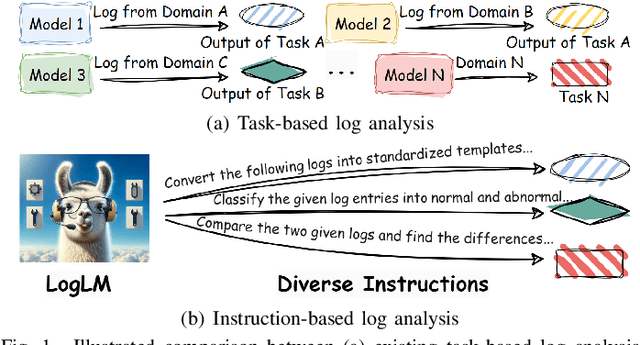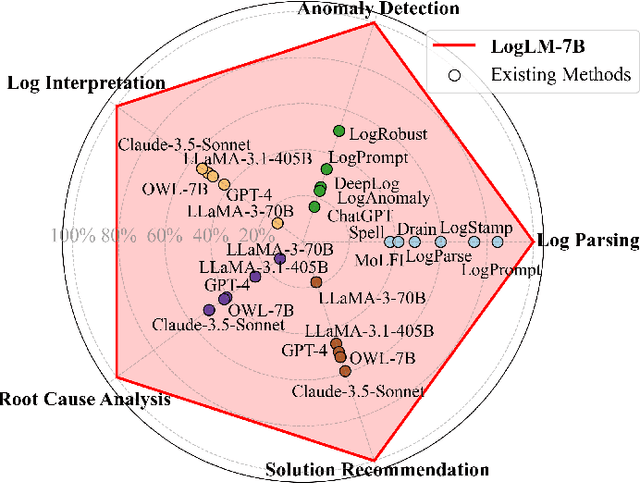Boxing Chen
Huawei Noah's Ark Lab
Resona: Improving Context Copying in Linear Recurrence Models with Retrieval
Mar 28, 2025Abstract:Recent shifts in the space of large language model (LLM) research have shown an increasing focus on novel architectures to compete with prototypical Transformer-based models that have long dominated this space. Linear recurrent models have proven to be a viable competitor due to their computational efficiency. However, such models still demonstrate a sizable gap compared to Transformers in terms of in-context learning among other tasks that require recalling information from a context. In this work, we introduce __Resona__, a simple and scalable framework for augmenting linear recurrent models with retrieval. __Resona__~augments models with the ability to integrate retrieved information from the provided input context, enabling tailored behavior to diverse task requirements. Experiments on a variety of linear recurrent models demonstrate that __Resona__-augmented models observe significant performance gains on a variety of synthetic as well as real-world natural language tasks, highlighting its ability to act as a general purpose method to improve the in-context learning and language modeling abilities of linear recurrent LLMs.
Balcony: A Lightweight Approach to Dynamic Inference of Generative Language Models
Mar 06, 2025Abstract:Deploying large language models (LLMs) in real-world applications is often hindered by strict computational and latency constraints. While dynamic inference offers the flexibility to adjust model behavior based on varying resource budgets, existing methods are frequently limited by hardware inefficiencies or performance degradation. In this paper, we introduce Balcony, a simple yet highly effective framework for depth-based dynamic inference. By freezing the pretrained LLM and inserting additional transformer layers at selected exit points, Balcony maintains the full model's performance while enabling real-time adaptation to different computational budgets. These additional layers are trained using a straightforward self-distillation loss, aligning the sub-model outputs with those of the full model. This approach requires significantly fewer training tokens and tunable parameters, drastically reducing computational costs compared to prior methods. When applied to the LLaMA3-8B model, using only 0.2% of the original pretraining data, Balcony achieves minimal performance degradation while enabling significant speedups. Remarkably, we show that Balcony outperforms state-of-the-art methods such as Flextron and Layerskip as well as other leading compression techniques on multiple models and at various scales, across a variety of benchmarks.
R1-T1: Fully Incentivizing Translation Capability in LLMs via Reasoning Learning
Feb 27, 2025Abstract:Despite recent breakthroughs in reasoning-enhanced large language models (LLMs) like DeepSeek-R1, incorporating inference-time reasoning into machine translation (MT), where human translators naturally employ structured, multi-layered reasoning chain-of-thoughts (CoTs), is yet underexplored. Existing methods either design a fixed CoT tailored for a specific MT sub-task (e.g., literature translation), or rely on synthesizing CoTs unaligned with humans and supervised fine-tuning (SFT) prone to catastrophic forgetting, limiting their adaptability to diverse translation scenarios. This paper introduces R1-Translator (R1-T1), a novel framework to achieve inference-time reasoning for general MT via reinforcement learning (RL) with human-aligned CoTs comprising six common patterns. Our approach pioneers three innovations: (1) extending reasoning-based translation beyond MT sub-tasks to six languages and diverse tasks (e.g., legal/medical domain adaptation, idiom resolution); (2) formalizing six expert-curated CoT templates that mirror hybrid human strategies like context-aware paraphrasing and back translation; and (3) enabling self-evolving CoT discovery and anti-forgetting adaptation through RL with KL-constrained rewards. Experimental results indicate a steady translation performance improvement in 21 languages and 80 translation directions on Flores-101 test set, especially on the 15 languages unseen from training, with its general multilingual abilities preserved compared with plain SFT.
ReGLA: Refining Gated Linear Attention
Feb 03, 2025Abstract:Recent advancements in Large Language Models (LLMs) have set themselves apart with their exceptional performance in complex language modelling tasks. However, these models are also known for their significant computational and storage requirements, primarily due to the quadratic computation complexity of softmax attention. To mitigate this issue, linear attention has been designed to reduce the quadratic space-time complexity that is inherent in standard transformers. In this work, we embarked on a comprehensive exploration of three key components that substantially impact the performance of the Gated Linear Attention module: feature maps, normalization, and the gating mechanism. We developed a feature mapping function to address some crucial issues that previous suggestions overlooked. Then we offered further rationale for the integration of normalization layers to stabilize the training process. Moreover, we explored the saturation phenomenon of the gating mechanism and augmented it with a refining module. We conducted extensive experiments and showed our architecture outperforms previous Gated Linear Attention mechanisms in extensive tasks including training from scratch and post-linearization with continual pre-training.
ZETA: Leveraging Z-order Curves for Efficient Top-k Attention
Jan 24, 2025Abstract:Over recent years, the Transformer has become a fundamental building block for sequence modeling architectures. Yet at its core is the use of self-attention, whose memory and computational cost grow quadratically with the sequence length $N$, rendering it prohibitively expensive for long sequences. A promising approach is top-$k$ attention, which selects only the $k$ most relevant tokens and achieves performance comparable to vanilla self-attention while significantly reducing space and computational demands. However, causal masks require the current query token to only attend to past tokens, preventing the existing top-$k$ attention method from efficiently searching for the most relevant tokens in parallel, thereby limiting training efficiency. In this work, we propose ZETA, leveraging \textbf{Z}-Order Curves for \textbf{E}fficient \textbf{T}op-$k$ \textbf{A}ttention, to enable parallel querying of past tokens for entire sequences. % in both space and time complexity of $\mathcal{O}(N \log N)$. We first theoretically show that the choice of key and query dimensions involves a trade-off between the curse of dimensionality and the preservation of relative distances after projection. In light of this insight, we propose reducing the dimensionality of keys and queries in contrast to values and further leverage $Z$-order curves to map low-dimensional keys and queries into \emph{one}-dimensional space, which permits parallel sorting, thereby largely improving the efficiency for top-$k$ token selection. Experimental results demonstrate that ZETA matches the performance of standard attention on the synthetic \textsc{Multi-Query Associative Recall} task and outperforms attention and its variants on \textsc{Long Range Arena} and \textsc{WikiText-103} language modeling.
Rethinking Post-Training Quantization: Introducing a Statistical Pre-Calibration Approach
Jan 15, 2025



Abstract:As Large Language Models (LLMs) become increasingly computationally complex, developing efficient deployment strategies, such as quantization, becomes crucial. State-of-the-art Post-training Quantization (PTQ) techniques often rely on calibration processes to maintain the accuracy of these models. However, while these calibration techniques can enhance performance in certain domains, they may not be as effective in others. This paper aims to draw attention to robust statistical approaches that can mitigate such issues. We propose a weight-adaptive PTQ method that can be considered a precursor to calibration-based PTQ methods, guiding the quantization process to preserve the distribution of weights by minimizing the Kullback-Leibler divergence between the quantized weights and the originally trained weights. This minimization ensures that the quantized model retains the Shannon information content of the original model to a great extent, guaranteeing robust and efficient deployment across many tasks. As such, our proposed approach can perform on par with most common calibration-based PTQ methods, establishing a new pre-calibration step for further adjusting the quantized weights with calibration. We show that our pre-calibration results achieve the same accuracy as some existing calibration-based PTQ methods on various LLMs.
Batch-Max: Higher LLM Throughput using Larger Batch Sizes and KV Cache Compression
Dec 07, 2024Abstract:Several works have developed eviction policies to remove key-value (KV) pairs from the KV cache for more efficient inference. The focus has been on compressing the KV cache after the input prompt has been processed for faster token generation. In settings with limited GPU memory, and when the input context is longer than the generation length, we show that by also compressing the KV cache during the input processing phase, larger batch sizes can be used resulting in significantly higher throughput while still maintaining the original model's accuracy.
Adapting Large Language Models to Log Analysis with Interpretable Domain Knowledge
Dec 02, 2024Abstract:The increasing complexity of computer systems necessitates innovative approaches to fault and error management, going beyond traditional manual log analysis. While existing solutions using large language models (LLMs) show promise, they are limited by a gap between natural and domain-specific languages, which restricts their effectiveness in real-world applications. Our approach addresses these limitations by integrating interpretable domain knowledge into open-source LLMs through continual pre-training (CPT), enhancing performance on log tasks while retaining natural language processing capabilities. We created a comprehensive dataset, NLPLog, with over 250,000 question-answer pairs to facilitate this integration. Our model, SuperLog, trained with this dataset, achieves the best performance across four log analysis tasks, surpassing the second-best model by an average of 12.01%. Our contributions include a novel CPT paradigm that significantly improves model performance, the development of SuperLog with state-of-the-art results, and the release of a large-scale dataset to support further research in this domain.
Do Robot Snakes Dream like Electric Sheep? Investigating the Effects of Architectural Inductive Biases on Hallucination
Oct 22, 2024



Abstract:The growth in prominence of large language models (LLMs) in everyday life can be largely attributed to their generative abilities, yet some of this is also owed to the risks and costs associated with their use. On one front is their tendency to \textit{hallucinate} false or misleading information, limiting their reliability. On another is the increasing focus on the computational limitations associated with traditional self-attention based LLMs, which has brought about new alternatives, in particular recurrent models, meant to overcome them. Yet it remains uncommon to consider these two concerns simultaneously. Do changes in architecture exacerbate/alleviate existing concerns about hallucinations? Do they affect how and where they occur? Through an extensive evaluation, we study how these architecture-based inductive biases affect the propensity to hallucinate. While hallucination remains a general phenomenon not limited to specific architectures, the situations in which they occur and the ease with which specific types of hallucinations can be induced can significantly differ based on the model architecture. These findings highlight the need for better understanding both these problems in conjunction with each other, as well as consider how to design more universal techniques for handling hallucinations.
LogLM: From Task-based to Instruction-based Automated Log Analysis
Oct 12, 2024



Abstract:Automatic log analysis is essential for the efficient Operation and Maintenance (O&M) of software systems, providing critical insights into system behaviors. However, existing approaches mostly treat log analysis as training a model to perform an isolated task, using task-specific log-label pairs. These task-based approaches are inflexible in generalizing to complex scenarios, depend on task-specific training data, and cost significantly when deploying multiple models. In this paper, we propose an instruction-based training approach that transforms log-label pairs from multiple tasks and domains into a unified format of instruction-response pairs. Our trained model, LogLM, can follow complex user instructions and generalize better across different tasks, thereby increasing flexibility and reducing the dependence on task-specific training data. By integrating major log analysis tasks into a single model, our approach also relieves model deployment burden. Experimentally, LogLM outperforms existing approaches across five log analysis capabilities, and exhibits strong generalization abilities on complex instructions and unseen tasks.
 Add to Chrome
Add to Chrome Add to Firefox
Add to Firefox Add to Edge
Add to Edge